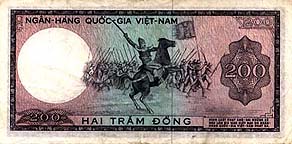02 January 2009
All Hands Information

(Annpolis BOQ, Saigon, 1969)
Editor’s Note: this article would have appeared somewhere before yesterday’s installment, which featured some post-fu feverish enthusiasm. All episodes will be meticulously reviewed to remove outright hallucinations.
The first two days of the Vietnam experience began, for most of the people in this part of Rex’s story, at the Bachelor Officers/ Bachelor Enlisted Quarters at what had been a distinctly seedy hotel. Now it was christened the Annapolis BOQ/BEQ.
My pal Peter remembers that it had multiple sandbagged .50 Calibre machine gun positions on the roof and a front door that looked like the entrance to a bunker. I was pouring over an old MAC-V map of the city to ascertain the landmarks of the old days.
I came across an interesting pamphlet, which contains information of critical nature to all incoming jet-lagged personnel, who have departed CONUS enroute the Republic of Vietnam via Braniff air charter. Brief stops for fuel in Hawaii and at Clark AFB in the Philippines, then a crew change for fresh hands with recent experience in landing in the cork-screw pattern required at Tan San Nhut.
There is an outsized bust of Ho Chi Minh in the lobby of the Air Transport Terminal there, or was, last time I saw it. It still was as Air Force a building as you can imagine.
A staff car scoops up the new guys, and then off to Annapolis. Not the old Navy town on the Severn River, but the seedy hotel downtown that is “Saigon’s Innkeeper.”

ALL HANDS INFORMATION
Welcome aboard the Annapolis BOQ/BEQ and the Republic of Vietnam. Depending upon which unit you are assigned to, you can expect to remain here approximately three days. During that time, with the exception of shipboard, HAL-3, VAL-4, RIVFLOT ONE, and TAD personnel, you will participate in an administrative briefing at which time you will complete your travel claims, Dislocation Allowance/ Family Separation Allowance, Postal Locator forms, Ration Card, and Currency Control Card applications.
Enlisted members will be counseled on their duty preferences for their next tour (VEY Interview). One of the members of the Master-at-Arms force will conduct an in-country security briefing and marijuana lecture to be attended by all new arrivals.
Later, depending upon your assignment, you will either draw a weapon or field gear, or both. Finally, you are required to take part in the Personal Response Discussion, conducted in Saigon.
While you are at the Annapolis, you are under the command of COMNAVSUPPACT, Saigon. In addition, there are a few rules which must be adhered to as well as some pertinent items important to you, namely:
1. Water
a. All water is non-potable with the exception of that in the coolers.
2. Head Facilities
a. A sewage problem exists. All the sewage, as well as the shower water and the water from the sinks is pumped into a 5,000 gallon tank. This is pumped out at various times, so use water sparingly and adhere to the posted Head Regulations.
3. Berthing Areas
a. Lying on bunks during working hours is prohibited. The one exception is from 1100-1300, but one must be in underwear only.
b. Personnel utilizing lockers will attach a card to their locker, showing their name and bunk number. This will be done on arrival and cards may be picked up in the Master-at-Arms office.
c. All lockers found untagged are subject to having locks cut and contents placed in the Lucky Bag.
d. There are women in this billet. Be courteous to them and use your heads with regard to dress while utilizing the head facilities.
4. Departing Billet
a. Before departing the Annapolis for any reason, you must log out with the Master-at- Arms. Upon returning you will log back in with the MAA.
b. E-6 and below who find it necessary to leave the Annapolis for any reason other than going to chow must have a signed chit authorizing the absence.
c. Before departing for your ultimate duty station, make certain you have cleaned your locker.
5. Musters
a. Musters are held at 0730, 1300, and 1700. Attendance is mandatory. Officers and E-7 and above are required to attend the 0730 musters only, in order to pass on necessary information.
b. Approximately 30 minutes after checking into the Annapolis you will be required to attend your first lecture, held in Bay 8. At this time all personnel will be given a security briefing and informed of their next lecture.
6. Watches
a. In order to defend the Annapolis in event of enemy attack and to ensure your safety, various watches have been established and men in grades E-1 thru E-6 may expect to be placed on the watch bill.
7. Watch Bill and Flight List
a. Be certain to check lists once the announcement has been made that they are posted.
8. Daily Charge
a. You will be charged 25 piasters per day while at this billet. This fee is used for linen service and to pay the maids for services rendered. You are reminded that this fee is to be paid in piasters only.
9. Uniforms
a. Civilian clothing, mixed uniforms, and camouflaged greens are not authorized in the Saigon area.
10. Personal appearance
a. Long hair, sideburns, and uncleanliness are not tolerated.
11. Lounge area (Bay 8)
a. This is a reading and TV viewing area only. Do not sleep there, nor put your feet on the furniture or the bulkheads.
12. Movies
a. Movies are shown five out of seven days from 1900-2000 in the Muster Bay.
13. Lobby and Quarterdeck
a. Pass quickly through this area. Do not congregate.
14. Outside area
a. Tables, chairs and trash cans have been put there for your convenience. Keep this area clean by putting waste and cigarette butts in the cans provided.
15. Annapolis Master-at-Arms Force
a. The purpose of the MAA is to enforce rules and regulations and to maintain security throughout the building.
b. Strict discipline will be adhered to while you are on board and rowdiness and unruly conduct will not be tolerated.
b. We solicit your cooperation in doing your part in order to make your stay more enjoyable.
(1) Willingly follow commands and regulations.
(2) Relate all problems such as lack of supplies, water pressure, uncleanliness, etc to the duty MAA.
(3) Conduct yourself in a courteous manner at all times.
16. Security and Theft
a. All gear adrift will be confiscated and placed in the lucky bag.
b. At no time should valuables such as watches, wallets, radios, etc., be left adrift.
c. Personnel are reminded that it is unwise to carry or possess large sums of money.
17. Messing
a. Officers will mess at the Idaho BOQ, which is located directly behind the Annapolis
b. Enlisted personnel will mess at the Montana BEQ, which is located about three blocks down the street from the Annapolis.
18. Liberty
a. There is no authorized liberty for transients in the Saigon/Cholon area; however you are allowed to utilize the facilities (including bar) at Idaho BOQ and Montana BEQ.
19. RIVFLOT ONE and Naval Advisory Personnel Assigned to Danang
a. RIVFLOT ONE personnel do not draw field gear or weapons from the Annapolis.
b. Naval Advisory personnel being assigned to Da Nang will not draw a weapon from the Annapolis armory, but will draw field gear from the Annapolis.
20. DON'T CONGREGATE!
a. At no time will anyone congregate around the entrance to the building and the front bunker. Standing outside the protected area and gathering groups is extremely dangerous – Charlie is watching ! ! !
DO's and DON'Ts
A few DO's:
1. Conduct yourself as gentlemen.
2. Remain in a complete, clean and neat uniform.
3. Pay all bills.
4. Treat all persons with due respect.
A few DON'Ts:
1. Don't become intoxicated.
2. Don' t become involved in political discussions.
3. Don't "talk shop" or discuss classified matters ashore.
4. Don't make tactless comparisons between conditions in Vietnam and the United States.
********
The Artful Logger tells me that for the people coming under Rex’s control, the two-day mandatory orientation at the Annapolis included weapons and gear issue, shedding an old life for these:
1 x M-16 w/ five magazines. .223 ammunition provided separately.
S&W.38 pistol with a box of ammo
Four sets of fatigues,
Helmet/flak-jacket/web gear.
The weapons were, in the case of the former, complex and subject to jamming in the weather unless meticulously maintained, and underpowered and under-capacity in the latter. The first thing was to identify a non-official weapons suite that suited your individual temperament. Jack Graf preferred the Swedish K, 9mm Carl Gustaf model 45, a very fine blowback-operated full automatic submachine gun with a 36 round detachable box magazine in the popular 9mm calibre.

(The Meyerkord Hotel, left, now home to the Vietnam Institute of Science and Technology, cannot be long for this world).
The next destination was another down-at-the-heels Continental-style hotel called the Meyerkord. It was more unobtrusive than the Annapolis, befitting its station as containing the NAVFOR-V "NILO Crash Pad" for transient personnel. The facility included a second-floor room with five beds, access to a shared head, and a view of the alley and entrance to Monique's Massage Parlor. Or if you prefered, a view of the riding grounds at the Presidential Palace from the roof.
NAVFORV was two blocks down the street, which is where Rex’s N-2 officers were located.
Rex would have missed the All Hands experience, since he would have stayed, as a senior officer, at the Rex Hotel. “Rex at the Rex,” must have been a source of amusement.

(Rex Hotel prior to restoration, 2002. Photo M. Hambert)
I booked our delegation into the Rex years later to ensure that I could see it before the great change that was coming. It was dark and hooded in aspect when I was there in 1995, and sure enough, it has been brightened and updated.
The piaster was the national currency of the Republic of Vietnam, and there was plenty of US currency available, though it was issued in Military scrip; MPC was the term for it, special notes printed to the specifications of MAC-V to inhibit black marketing, which it might have done.
The official exchange rate was between 80 and 90 per US dollar, though all sorts of games were played with it. The troops were able to change, sometimes, at a sanctioned rate of nearly 120 piasters per dollar. That was a sanctioned profit of near a third, if traded directly to the locals, but shrewd bargainers unafraid of the consequences could drive a deal down to 50- which was something like 140% profit.

(200 Piaster Note)
This, of course, was the province of those who lived in Sai Gon, and not that of the men who went to the field. There are always at least two wars in any given place; the one that is being fought by the combatants, and the one in the rear conducted against those actually fighting.
My pal Drifty Pacer worked unattended ground sensors in the country around the Parrot’s Beak. He told me he when he was summoned to visit the NAVFOR HQ, he would always try to wear his best cammies and bath in the canal before departing for the city.
His weapons were not regulation, and his uniform was shabby in comparison with those who could shop for tailored fatigues and enjoy the luxury of pick-up washing and pressing.
The hassles began at the first American check-point, where the MPs glowered at the muscular former Big Ten lineman.
My pal Steve Canyon told me one time that he was barreling along Bernard Fall’s Street Without Joy, festooned with mini-grenades and a shot gun on the hump next to him when he was stopped for speeding by some newly-arrived MPs eager to make a safer driving experience in a known ambush zone.
You can imagine how his fingers twitched, looking up at the idiot with the white belt and brassard.
I mention all this not because this war was worse or better than the ones in progress now. It was not my war, but it was Rex’s, and those for whom he was briefly responsible. It is those pivotal months from mid-1968 to 1969 that distilled themselves in memory to those that defined a whole life.
Copyright 2010 Vic Socotra
www.vicsocotra.com
Subscribe to the RSS feed!